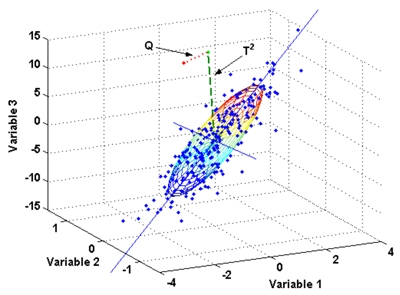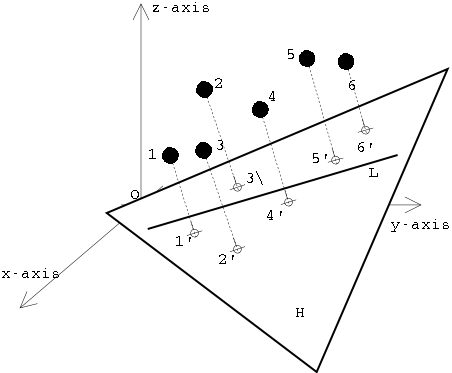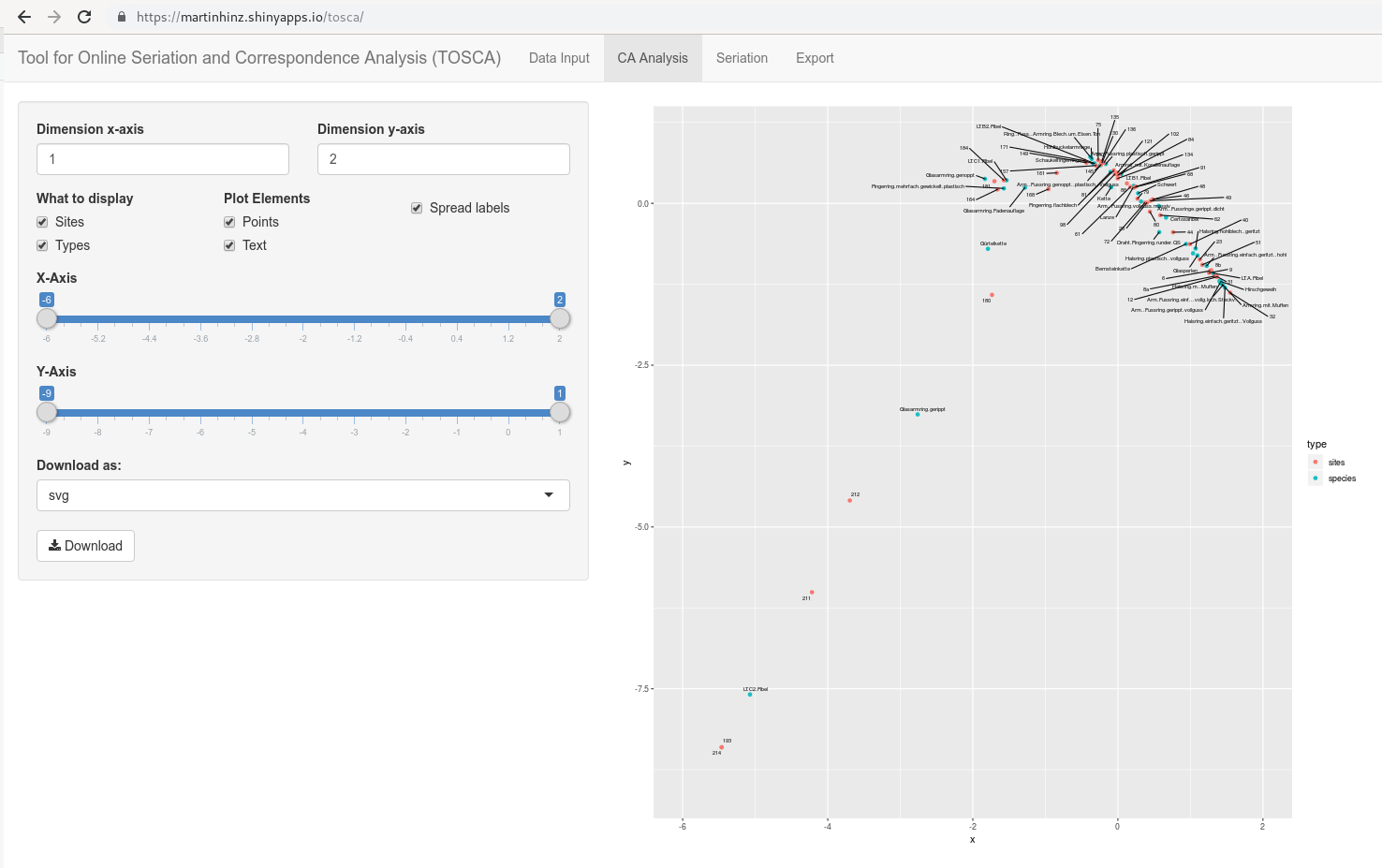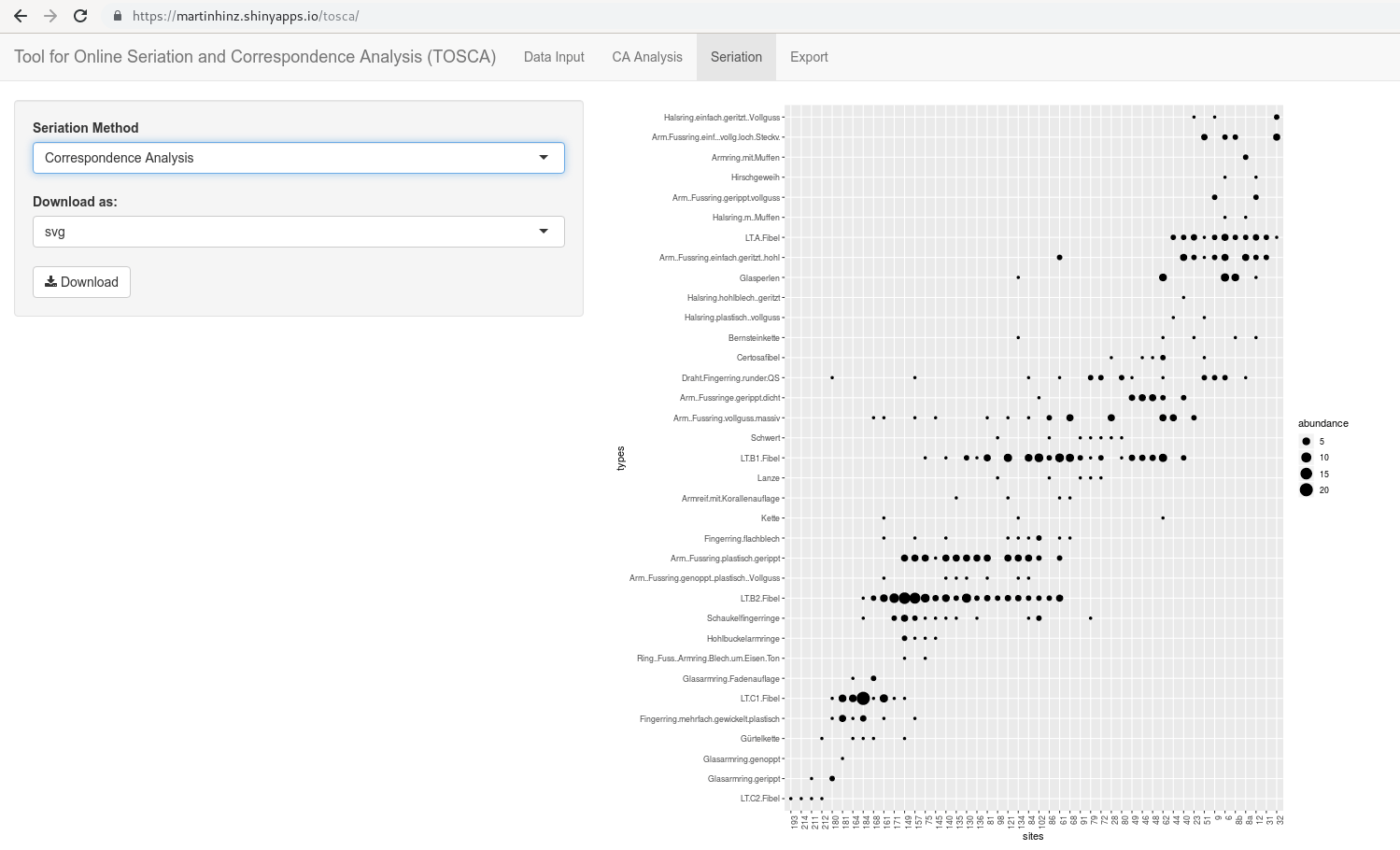class: title-slide, center, middle # Statistical methods for archaeological data analysis I: Basic methods ## 12 - Correspondence Analysis ### Martin Hinz #### Institut für Archäologische Wissenschaften, Universität Bern 29.05.2019 --- ## Correspondence analysis: idea and basics [1] ### Similar things have similar characteristics...[2] **Visual explorative/descriptive method** - Correspondence analysis does not work with significances, therefore it does not 'proof' anything - Visualization of contingency tables or presence/absence matrices **Idea** - Representation of items (*sites*) and properties (Variables, *species*) in a common space (coordinate system) - Data that is related to each other is more closely related represented next to each other - Similarities are calculated using chi-square methods **Prerequisites** A data matrix with at least nominally scaled variables, therefore especially suitable for archaeological questions --- ## Correspondence analysis: idea and basics [1] ### Similar things have similar characteristics... **General procedure** - Standardizing the data to a comparable measure - "Projection" of the data into a multidimensional variable space - determining the vectors which stepwise contain most of the information (variability) of the data and are oriented perpendicular to each other - "Projection" of the data onto these vectors - Representation of the position of the data on these vectors in a diagram --- .pull-left[ ### multidimentional data space  .caption[.tiny[source: http://www.aapspharmscitech.org]] ] .pull-right[ ### projection of points onto a plane  .caption[.tiny[source: http://www.cs.mcgill.ca]] ] --- ## Correspondence Analysis: History ### General information - Development in the field of biology and psychology - Algebrarian Foundations 1940s (Hartley/Guttman) - First explicit use by Benzéncri in the 1960s linguistic studies - Further development in various research groups → resulted in different versions and names of the procedure - 1984 Greenacre basic monograph on the method ### In archaeology - First Seriation: Sir William Flinders-Petrie 1899 - First major trials with seriating methods in Germany Goldman 1979 with reciprocal averaging. - Wide application of the procedure for chronological sorting of the Rhineland Linear Pottery - Continuation by institutes Cologne and Kiel (Zimmermann, Müller) --- ## Correspondence Analysis: Procedure ### Preparation: contingency table, if necessary **Presence Absence Matrix** Notes the presence or absence of a characteristic for a unit, which is the most widely used base in archaeology | | Pot | Cup | Fibula | Sum | |---------|-----|-----|--------|-----| | Burial1 | 1 | 1 | 0 | 2 | | Burial2 | 0 | 1 | 1 | 2 | | Burial3 | 1 | 1 | 1 | 3 | | Burial4 | 1 | 0 | 1 | 2 | | Sum | 3 | 3 | 3 | 9 | Prerequisite: total number of filled cells per column at least 2, total per row at least 2 --- ## Preparation: contingency table, if necessary ### contingency table Notes the number of a characteristics for a unit or a group of units | | Pot | Cup | Fibula | Sum | |-------------|-----|-----|--------|-----| | Settlements | 20 | 23 | 40 | 83 | | Hoards | 23 | 10 | 6 | 39 | | Burials | 10 | 56 | 4 | 70 | | Sum | 53 | 89 | 50 | 192 | Also possible: Burt-Matrix, if you want, you can ask me for details after the lecture... --- ## Correspondence analysis: Procedure (using a presence/absence matrix) ### Preparation: Standardising to relative frequency Calculation: Divide each cell by the total sum .tiny[ .pull-left[ <table> <thead> <tr> <th style="text-align:left;"> </th> <th style="text-align:right;"> pot </th> <th style="text-align:right;"> cup </th> <th style="text-align:right;"> fibula </th> <th style="text-align:right;"> Sum </th> </tr> </thead> <tbody> <tr> <td style="text-align:left;"> burial1 </td> <td style="text-align:right;"> 1 </td> <td style="text-align:right;"> 1 </td> <td style="text-align:right;"> 0 </td> <td style="text-align:right;"> 2 </td> </tr> <tr> <td style="text-align:left;"> burial2 </td> <td style="text-align:right;"> 0 </td> <td style="text-align:right;"> 1 </td> <td style="text-align:right;"> 1 </td> <td style="text-align:right;"> 2 </td> </tr> <tr> <td style="text-align:left;"> burial3 </td> <td style="text-align:right;"> 1 </td> <td style="text-align:right;"> 1 </td> <td style="text-align:right;"> 1 </td> <td style="text-align:right;"> 3 </td> </tr> <tr> <td style="text-align:left;"> burial4 </td> <td style="text-align:right;"> 1 </td> <td style="text-align:right;"> 0 </td> <td style="text-align:right;"> 1 </td> <td style="text-align:right;"> 2 </td> </tr> <tr> <td style="text-align:left;"> Sum </td> <td style="text-align:right;"> 3 </td> <td style="text-align:right;"> 3 </td> <td style="text-align:right;"> 3 </td> <td style="text-align:right;"> 9 </td> </tr> </tbody> </table> ] .pull-right[ <table> <thead> <tr> <th style="text-align:left;"> </th> <th style="text-align:right;"> pot </th> <th style="text-align:right;"> cup </th> <th style="text-align:right;"> fibula </th> <th style="text-align:right;"> Sum </th> </tr> </thead> <tbody> <tr> <td style="text-align:left;"> burial1 </td> <td style="text-align:right;"> 0.11 </td> <td style="text-align:right;"> 0.11 </td> <td style="text-align:right;"> 0.00 </td> <td style="text-align:right;"> 0.22 </td> </tr> <tr> <td style="text-align:left;"> burial2 </td> <td style="text-align:right;"> 0.00 </td> <td style="text-align:right;"> 0.11 </td> <td style="text-align:right;"> 0.11 </td> <td style="text-align:right;"> 0.22 </td> </tr> <tr> <td style="text-align:left;"> burial3 </td> <td style="text-align:right;"> 0.11 </td> <td style="text-align:right;"> 0.11 </td> <td style="text-align:right;"> 0.11 </td> <td style="text-align:right;"> 0.33 </td> </tr> <tr> <td style="text-align:left;"> burial4 </td> <td style="text-align:right;"> 0.11 </td> <td style="text-align:right;"> 0.00 </td> <td style="text-align:right;"> 0.11 </td> <td style="text-align:right;"> 0.22 </td> </tr> <tr> <td style="text-align:left;"> Sum </td> <td style="text-align:right;"> 0.33 </td> <td style="text-align:right;"> 0.33 </td> <td style="text-align:right;"> 0.33 </td> <td style="text-align:right;"> 1.00 </td> </tr> </tbody> </table> ] ] Margins of the table stored for calculation of expectation values and scaling the result later on: .tiny[ Row profile: ``` ## burial1 burial2 burial3 burial4 ## 0.22 0.22 0.33 0.22 ``` Column profile: ``` ## pot cup fibula ## 0.33 0.33 0.33 ``` ] --- ## Correspondence analysis: Procedure (using a presence/absence matrix) ### Preparation: Calculation of expected values .pull-left[ <table> <thead> <tr> <th style="text-align:left;"> </th> <th style="text-align:right;"> pot </th> <th style="text-align:right;"> cup </th> <th style="text-align:right;"> fibula </th> <th style="text-align:right;"> Sum </th> </tr> </thead> <tbody> <tr> <td style="text-align:left;"> burial1 </td> <td style="text-align:right;"> 0.11 </td> <td style="text-align:right;"> 0.11 </td> <td style="text-align:right;"> 0.00 </td> <td style="text-align:right;"> 0.22 </td> </tr> <tr> <td style="text-align:left;"> burial2 </td> <td style="text-align:right;"> 0.00 </td> <td style="text-align:right;"> 0.11 </td> <td style="text-align:right;"> 0.11 </td> <td style="text-align:right;"> 0.22 </td> </tr> <tr> <td style="text-align:left;"> burial3 </td> <td style="text-align:right;"> 0.11 </td> <td style="text-align:right;"> 0.11 </td> <td style="text-align:right;"> 0.11 </td> <td style="text-align:right;"> 0.33 </td> </tr> <tr> <td style="text-align:left;"> burial4 </td> <td style="text-align:right;"> 0.11 </td> <td style="text-align:right;"> 0.00 </td> <td style="text-align:right;"> 0.11 </td> <td style="text-align:right;"> 0.22 </td> </tr> <tr> <td style="text-align:left;"> Sum </td> <td style="text-align:right;"> 0.33 </td> <td style="text-align:right;"> 0.33 </td> <td style="text-align:right;"> 0.33 </td> <td style="text-align:right;"> 1.00 </td> </tr> </tbody> </table> ] .pull-right[ <table> <thead> <tr> <th style="text-align:left;"> </th> <th style="text-align:right;"> pot </th> <th style="text-align:right;"> cup </th> <th style="text-align:right;"> fibula </th> <th style="text-align:right;"> Sum </th> </tr> </thead> <tbody> <tr> <td style="text-align:left;"> </td> <td style="text-align:right;"> 0.07 </td> <td style="text-align:right;"> 0.07 </td> <td style="text-align:right;"> 0.07 </td> <td style="text-align:right;"> 0.22 </td> </tr> <tr> <td style="text-align:left;"> </td> <td style="text-align:right;"> 0.07 </td> <td style="text-align:right;"> 0.07 </td> <td style="text-align:right;"> 0.07 </td> <td style="text-align:right;"> 0.22 </td> </tr> <tr> <td style="text-align:left;"> </td> <td style="text-align:right;"> 0.11 </td> <td style="text-align:right;"> 0.11 </td> <td style="text-align:right;"> 0.11 </td> <td style="text-align:right;"> 0.33 </td> </tr> <tr> <td style="text-align:left;"> </td> <td style="text-align:right;"> 0.07 </td> <td style="text-align:right;"> 0.07 </td> <td style="text-align:right;"> 0.07 </td> <td style="text-align:right;"> 0.22 </td> </tr> <tr> <td style="text-align:left;"> Sum </td> <td style="text-align:right;"> 0.33 </td> <td style="text-align:right;"> 0.33 </td> <td style="text-align:right;"> 0.33 </td> <td style="text-align:right;"> 1.00 </td> </tr> </tbody> </table> ] --- ## Correspondence analysis: Procedure (using a presence/absence matrix) .pull-left[ ### Preparation: Calculation of standardised values `\(\chi^2=\sum_{i=1}^n \frac{(O_i - E_i)^2}{E_i}\)` `\(z_{ij}=\frac{(O_i - E_i)}{\sqrt{E_i}}\)` <table> <thead> <tr> <th style="text-align:left;"> </th> <th style="text-align:right;"> pot </th> <th style="text-align:right;"> cup </th> <th style="text-align:right;"> fibula </th> <th style="text-align:right;"> Sum </th> </tr> </thead> <tbody> <tr> <td style="text-align:left;"> burial1 </td> <td style="text-align:right;"> 0.14 </td> <td style="text-align:right;"> 0.14 </td> <td style="text-align:right;"> -0.27 </td> <td style="text-align:right;"> 0 </td> </tr> <tr> <td style="text-align:left;"> burial2 </td> <td style="text-align:right;"> -0.27 </td> <td style="text-align:right;"> 0.14 </td> <td style="text-align:right;"> 0.14 </td> <td style="text-align:right;"> 0 </td> </tr> <tr> <td style="text-align:left;"> burial3 </td> <td style="text-align:right;"> 0.00 </td> <td style="text-align:right;"> 0.00 </td> <td style="text-align:right;"> 0.00 </td> <td style="text-align:right;"> 0 </td> </tr> <tr> <td style="text-align:left;"> burial4 </td> <td style="text-align:right;"> 0.14 </td> <td style="text-align:right;"> -0.27 </td> <td style="text-align:right;"> 0.14 </td> <td style="text-align:right;"> 0 </td> </tr> <tr> <td style="text-align:left;"> Sum </td> <td style="text-align:right;"> 0.00 </td> <td style="text-align:right;"> 0.00 </td> <td style="text-align:right;"> 0.00 </td> <td style="text-align:right;"> 0 </td> </tr> </tbody> </table> ] .pull-right[ ### Inertia Measurement for the spread of the data in relation to the number of cases `\(I = \frac{\chi^2}{n} = \sum_i \sum_j z_{ij}^2\)` Inertia here: 0.3333333 ] --- <div id="rgl89209" style="width:504px;height:504px;" class="rglWebGL html-widget"></div> <script type="application/json" data-for="rgl89209">{"x":{"material":{"color":"#000000","alpha":1,"lit":true,"ambient":"#000000","specular":"#FFFFFF","emission":"#000000","shininess":50,"smooth":true,"front":"filled","back":"filled","size":3,"lwd":1,"fog":false,"point_antialias":false,"line_antialias":false,"texture":null,"textype":"rgb","texmipmap":false,"texminfilter":"linear","texmagfilter":"linear","texenvmap":false,"depth_mask":true,"depth_test":"less","isTransparent":false,"polygon_offset":[0,0]},"rootSubscene":1,"objects":{"7":{"id":7,"type":"spheres","material":{},"vertices":[[0.136082768440247,0.136082768440247,-0.272165536880493],[-0.272165536880493,0.136082768440247,0.136082768440247],[0,0,0],[0.136082768440247,-0.272165536880493,0.136082768440247]],"colors":[[0,0,0,1]],"radii":[[0.00680413795635104]],"centers":[[0.136082768440247,0.136082768440247,-0.272165536880493],[-0.272165536880493,0.136082768440247,0.136082768440247],[0,0,0],[0.136082768440247,-0.272165536880493,0.136082768440247]],"ignoreExtent":false,"flags":3},"9":{"id":9,"type":"text","material":{"lit":false},"vertices":[[-0.0680413842201233,-0.35047435760498,-0.35047435760498]],"colors":[[0,0,0,1]],"texts":[["z[, 1]"]],"cex":[[1]],"adj":[[0.5,0.5]],"centers":[[-0.0680413842201233,-0.35047435760498,-0.35047435760498]],"family":[["sans"]],"font":[[1]],"ignoreExtent":true,"flags":2064},"10":{"id":10,"type":"text","material":{"lit":false},"vertices":[[-0.35047435760498,-0.0680413842201233,-0.35047435760498]],"colors":[[0,0,0,1]],"texts":[["z[, 2]"]],"cex":[[1]],"adj":[[0.5,0.5]],"centers":[[-0.35047435760498,-0.0680413842201233,-0.35047435760498]],"family":[["sans"]],"font":[[1]],"ignoreExtent":true,"flags":2064},"11":{"id":11,"type":"text","material":{"lit":false},"vertices":[[-0.35047435760498,-0.35047435760498,-0.0680413842201233]],"colors":[[0,0,0,1]],"texts":[["z[, 3]"]],"cex":[[1]],"adj":[[0.5,0.5]],"centers":[[-0.35047435760498,-0.35047435760498,-0.0680413842201233]],"family":[["sans"]],"font":[[1]],"ignoreExtent":true,"flags":2064},"12":{"id":12,"type":"text","material":{"lit":false},"vertices":[[0.136082768440247,0.136082768440247,-0.272165536880493],[-0.272165536880493,0.136082768440247,0.136082768440247],[0,0,0],[0.136082768440247,-0.272165536880493,0.136082768440247]],"colors":[[0,0,0,1]],"texts":[["burial1"],["burial2"],["burial3"],["burial4"]],"cex":[[1]],"adj":[[0.5,0.5]],"centers":[[0.136082768440247,0.136082768440247,-0.272165536880493],[-0.272165536880493,0.136082768440247,0.136082768440247],[0,0,0],[0.136082768440247,-0.272165536880493,0.136082768440247]],"family":[["sans"]],"font":[[1]],"ignoreExtent":false,"flags":2064},"5":{"id":5,"type":"light","vertices":[[0,0,1]],"colors":[[1,1,1,1],[1,1,1,1],[1,1,1,1]],"viewpoint":true,"finite":false},"4":{"id":4,"type":"background","material":{"fog":true},"colors":[[0.298039227724075,0.298039227724075,0.298039227724075,1]],"centers":[[0,0,0]],"sphere":false,"fogtype":"none","flags":0},"6":{"id":6,"type":"background","material":{"lit":false,"back":"lines"},"colors":[[1,1,1,1]],"centers":[[0,0,0]],"sphere":false,"fogtype":"none","flags":0},"8":{"id":8,"type":"bboxdeco","material":{"front":"lines","back":"lines"},"vertices":[[-0.200000002980232,"NA","NA"],[-0.100000001490116,"NA","NA"],[0,"NA","NA"],[0.100000001490116,"NA","NA"],["NA",-0.200000002980232,"NA"],["NA",-0.100000001490116,"NA"],["NA",0,"NA"],["NA",0.100000001490116,"NA"],["NA","NA",-0.200000002980232],["NA","NA",-0.100000001490116],["NA","NA",0],["NA","NA",0.100000001490116]],"colors":[[0,0,0,1]],"draw_front":true,"newIds":[20,21,22,23,24,25,26]},"1":{"id":1,"type":"subscene","par3d":{"antialias":8,"FOV":30,"ignoreExtent":false,"listeners":1,"mouseMode":{"left":"trackball","right":"zoom","middle":"fov","wheel":"pull"},"observer":[0,0,1.78797578811646],"modelMatrix":[[1,0,0,0.0680413916707039],[0,0.342020153999329,0.939692616462708,0.0872095227241516],[0,-0.939692616462708,0.342020153999329,-1.82864224910736],[0,0,0,1]],"projMatrix":[[3.73205089569092,0,0,0],[0,3.73205089569092,0,0],[0,0,-3.86370325088501,-6.4454460144043],[0,0,-1,0]],"skipRedraw":false,"userMatrix":[[1,0,0,0],[0,0.342020143325668,0.939692620785909,0],[0,-0.939692620785909,0.342020143325668,0],[0,0,0,1]],"userProjection":[[1,0,0,0],[0,1,0,0],[0,0,1,0],[0,0,0,1]],"scale":[1,1,1],"viewport":{"x":0,"y":0,"width":1,"height":1},"zoom":1,"bbox":[-0.278969675302505,0.142886906862259,-0.278969675302505,0.142886906862259,-0.278969675302505,0.142886906862259],"windowRect":[1980,132,2236,388],"family":"sans","font":1,"cex":1,"useFreeType":true,"fontname":"/home/martin/R/x86_64-pc-linux-gnu-library/3.6/rgl/fonts/FreeSans.ttf","maxClipPlanes":8,"glVersion":4.59999990463257,"activeSubscene":0},"embeddings":{"viewport":"replace","projection":"replace","model":"replace","mouse":"replace"},"objects":[6,8,7,9,10,11,12,5,20,21,22,23,24,25,26],"subscenes":[],"flags":2643},"20":{"id":20,"type":"lines","material":{"lit":false},"vertices":[[-0.200000002980232,-0.285297513008118,-0.285297513008118],[0.100000001490116,-0.285297513008118,-0.285297513008118],[-0.200000002980232,-0.285297513008118,-0.285297513008118],[-0.200000002980232,-0.296160340309143,-0.296160340309143],[-0.100000001490116,-0.285297513008118,-0.285297513008118],[-0.100000001490116,-0.296160340309143,-0.296160340309143],[0,-0.285297513008118,-0.285297513008118],[0,-0.296160340309143,-0.296160340309143],[0.100000001490116,-0.285297513008118,-0.285297513008118],[0.100000001490116,-0.296160340309143,-0.296160340309143]],"colors":[[0,0,0,1]],"centers":[[-0.0500000007450581,-0.285297513008118,-0.285297513008118],[-0.200000002980232,-0.29072892665863,-0.29072892665863],[-0.100000001490116,-0.29072892665863,-0.29072892665863],[0,-0.29072892665863,-0.29072892665863],[0.100000001490116,-0.29072892665863,-0.29072892665863]],"ignoreExtent":true,"origId":8,"flags":64},"21":{"id":21,"type":"text","material":{"lit":false},"vertices":[[-0.200000002980232,-0.317885935306549,-0.317885935306549],[-0.100000001490116,-0.317885935306549,-0.317885935306549],[0,-0.317885935306549,-0.317885935306549],[0.100000001490116,-0.317885935306549,-0.317885935306549]],"colors":[[0,0,0,1]],"texts":[["-0.2"],["-0.1"],["0"],["0.1"]],"cex":[[1]],"adj":[[0.5,0.5]],"centers":[[-0.200000002980232,-0.317885935306549,-0.317885935306549],[-0.100000001490116,-0.317885935306549,-0.317885935306549],[0,-0.317885935306549,-0.317885935306549],[0.100000001490116,-0.317885935306549,-0.317885935306549]],"family":[["sans"]],"font":[[1]],"ignoreExtent":true,"origId":8,"flags":2064},"22":{"id":22,"type":"lines","material":{"lit":false},"vertices":[[-0.285297513008118,-0.200000002980232,-0.285297513008118],[-0.285297513008118,0.100000001490116,-0.285297513008118],[-0.285297513008118,-0.200000002980232,-0.285297513008118],[-0.296160340309143,-0.200000002980232,-0.296160340309143],[-0.285297513008118,-0.100000001490116,-0.285297513008118],[-0.296160340309143,-0.100000001490116,-0.296160340309143],[-0.285297513008118,0,-0.285297513008118],[-0.296160340309143,0,-0.296160340309143],[-0.285297513008118,0.100000001490116,-0.285297513008118],[-0.296160340309143,0.100000001490116,-0.296160340309143]],"colors":[[0,0,0,1]],"centers":[[-0.285297513008118,-0.0500000007450581,-0.285297513008118],[-0.29072892665863,-0.200000002980232,-0.29072892665863],[-0.29072892665863,-0.100000001490116,-0.29072892665863],[-0.29072892665863,0,-0.29072892665863],[-0.29072892665863,0.100000001490116,-0.29072892665863]],"ignoreExtent":true,"origId":8,"flags":64},"23":{"id":23,"type":"text","material":{"lit":false},"vertices":[[-0.317885935306549,-0.200000002980232,-0.317885935306549],[-0.317885935306549,-0.100000001490116,-0.317885935306549],[-0.317885935306549,0,-0.317885935306549],[-0.317885935306549,0.100000001490116,-0.317885935306549]],"colors":[[0,0,0,1]],"texts":[["-0.2"],["-0.1"],["0"],["0.1"]],"cex":[[1]],"adj":[[0.5,0.5]],"centers":[[-0.317885935306549,-0.200000002980232,-0.317885935306549],[-0.317885935306549,-0.100000001490116,-0.317885935306549],[-0.317885935306549,0,-0.317885935306549],[-0.317885935306549,0.100000001490116,-0.317885935306549]],"family":[["sans"]],"font":[[1]],"ignoreExtent":true,"origId":8,"flags":2064},"24":{"id":24,"type":"lines","material":{"lit":false},"vertices":[[-0.285297513008118,-0.285297513008118,-0.200000002980232],[-0.285297513008118,-0.285297513008118,0.100000001490116],[-0.285297513008118,-0.285297513008118,-0.200000002980232],[-0.296160340309143,-0.296160340309143,-0.200000002980232],[-0.285297513008118,-0.285297513008118,-0.100000001490116],[-0.296160340309143,-0.296160340309143,-0.100000001490116],[-0.285297513008118,-0.285297513008118,0],[-0.296160340309143,-0.296160340309143,0],[-0.285297513008118,-0.285297513008118,0.100000001490116],[-0.296160340309143,-0.296160340309143,0.100000001490116]],"colors":[[0,0,0,1]],"centers":[[-0.285297513008118,-0.285297513008118,-0.0500000007450581],[-0.29072892665863,-0.29072892665863,-0.200000002980232],[-0.29072892665863,-0.29072892665863,-0.100000001490116],[-0.29072892665863,-0.29072892665863,0],[-0.29072892665863,-0.29072892665863,0.100000001490116]],"ignoreExtent":true,"origId":8,"flags":64},"25":{"id":25,"type":"text","material":{"lit":false},"vertices":[[-0.317885935306549,-0.317885935306549,-0.200000002980232],[-0.317885935306549,-0.317885935306549,-0.100000001490116],[-0.317885935306549,-0.317885935306549,0],[-0.317885935306549,-0.317885935306549,0.100000001490116]],"colors":[[0,0,0,1]],"texts":[["-0.2"],["-0.1"],["0"],["0.1"]],"cex":[[1]],"adj":[[0.5,0.5]],"centers":[[-0.317885935306549,-0.317885935306549,-0.200000002980232],[-0.317885935306549,-0.317885935306549,-0.100000001490116],[-0.317885935306549,-0.317885935306549,0],[-0.317885935306549,-0.317885935306549,0.100000001490116]],"family":[["sans"]],"font":[[1]],"ignoreExtent":true,"origId":8,"flags":2064},"26":{"id":26,"type":"lines","material":{"lit":false},"vertices":[[-0.285297513008118,-0.285297513008118,-0.285297513008118],[-0.285297513008118,0.149214759469032,-0.285297513008118],[-0.285297513008118,-0.285297513008118,0.149214759469032],[-0.285297513008118,0.149214759469032,0.149214759469032],[-0.285297513008118,-0.285297513008118,-0.285297513008118],[-0.285297513008118,-0.285297513008118,0.149214759469032],[-0.285297513008118,0.149214759469032,-0.285297513008118],[-0.285297513008118,0.149214759469032,0.149214759469032],[-0.285297513008118,-0.285297513008118,-0.285297513008118],[0.149214759469032,-0.285297513008118,-0.285297513008118],[-0.285297513008118,-0.285297513008118,0.149214759469032],[0.149214759469032,-0.285297513008118,0.149214759469032],[-0.285297513008118,0.149214759469032,-0.285297513008118],[0.149214759469032,0.149214759469032,-0.285297513008118],[-0.285297513008118,0.149214759469032,0.149214759469032],[0.149214759469032,0.149214759469032,0.149214759469032],[0.149214759469032,-0.285297513008118,-0.285297513008118],[0.149214759469032,0.149214759469032,-0.285297513008118],[0.149214759469032,-0.285297513008118,0.149214759469032],[0.149214759469032,0.149214759469032,0.149214759469032],[0.149214759469032,-0.285297513008118,-0.285297513008118],[0.149214759469032,-0.285297513008118,0.149214759469032],[0.149214759469032,0.149214759469032,-0.285297513008118],[0.149214759469032,0.149214759469032,0.149214759469032]],"colors":[[0,0,0,1]],"centers":[[-0.285297513008118,-0.0680413767695427,-0.285297513008118],[-0.285297513008118,-0.0680413767695427,0.149214759469032],[-0.285297513008118,-0.285297513008118,-0.0680413767695427],[-0.285297513008118,0.149214759469032,-0.0680413767695427],[-0.0680413767695427,-0.285297513008118,-0.285297513008118],[-0.0680413767695427,-0.285297513008118,0.149214759469032],[-0.0680413767695427,0.149214759469032,-0.285297513008118],[-0.0680413767695427,0.149214759469032,0.149214759469032],[0.149214759469032,-0.0680413767695427,-0.285297513008118],[0.149214759469032,-0.0680413767695427,0.149214759469032],[0.149214759469032,-0.285297513008118,-0.0680413767695427],[0.149214759469032,0.149214759469032,-0.0680413767695427]],"ignoreExtent":true,"origId":8,"flags":64},"33":{"id":33,"type":"linestrip","material":{"alpha":0.498039215803146,"lit":false,"depth_test":"always","isTransparent":true},"vertices":[[0,0,-0.999000012874603],[1,0,-0.999000012874603],[1,1,-0.999000012874603],[0,1,-0.999000012874603],[0,0,-0.999000012874603]],"colors":[[0,0,0,0.498039215803146]],"centers":[[0,0,-0.999000012874603],[1,0,-0.999000012874603],[1,1,-0.999000012874603],[0,1,-0.999000012874603],[0,0,-0.999000012874603]],"ignoreExtent":false,"flags":32864}},"crosstalk":{"key":[null],"group":"","id":0,"options":[null]},"width":504,"height":504,"brushId":33,"sphereVerts":{"vb":[[0,0,0,0,0,0,0,0,0,0,0,0,0,0,0,0,0,0,0.0746578340503426,0.146446609406726,0.212607523691814,0.270598050073099,0.318189645143208,0.353553390593274,0.375330277517865,0.38268343236509,0.375330277517865,0.353553390593274,0.318189645143208,0.270598050073099,0.212607523691814,0.146446609406726,0.0746578340503426,0,0,0.137949689641472,0.270598050073099,0.392847479193551,0.5,0.587937801209679,0.653281482438188,0.693519922661074,0.707106781186547,0.693519922661074,0.653281482438188,0.587937801209679,0.5,0.392847479193551,0.270598050073099,0.137949689641472,0,0,0.180239955501737,0.353553390593274,0.513279967159337,0.653281482438188,0.768177756711416,0.853553390593274,0.906127446352888,0.923879532511287,0.906127446352888,0.853553390593274,0.768177756711416,0.653281482438188,0.513279967159337,0.353553390593274,0.180239955501737,0,0,0.195090322016128,0.38268343236509,0.555570233019602,0.707106781186548,0.831469612302545,0.923879532511287,0.98078528040323,1,0.98078528040323,0.923879532511287,0.831469612302545,0.707106781186548,0.555570233019602,0.38268343236509,0.195090322016128,0,0,0.180239955501737,0.353553390593274,0.513279967159337,0.653281482438188,0.768177756711416,0.853553390593274,0.906127446352888,0.923879532511287,0.906127446352888,0.853553390593274,0.768177756711416,0.653281482438188,0.513279967159337,0.353553390593274,0.180239955501737,0,0,0.137949689641472,0.270598050073099,0.392847479193551,0.5,0.587937801209679,0.653281482438188,0.693519922661074,0.707106781186548,0.693519922661074,0.653281482438188,0.587937801209679,0.5,0.392847479193551,0.270598050073099,0.137949689641472,0,0,0.0746578340503427,0.146446609406726,0.212607523691814,0.270598050073099,0.318189645143209,0.353553390593274,0.375330277517865,0.38268343236509,0.375330277517865,0.353553390593274,0.318189645143209,0.270598050073099,0.212607523691814,0.146446609406726,0.0746578340503427,0,0,0,0,0,0,0,0,0,0,0,0,0,0,0,0,0,0,-0,-0.0746578340503427,-0.146446609406726,-0.212607523691814,-0.270598050073099,-0.318189645143209,-0.353553390593274,-0.375330277517865,-0.38268343236509,-0.375330277517865,-0.353553390593274,-0.318189645143209,-0.270598050073099,-0.212607523691814,-0.146446609406726,-0.0746578340503427,-0,-0,-0.137949689641472,-0.270598050073099,-0.392847479193551,-0.5,-0.587937801209679,-0.653281482438188,-0.693519922661074,-0.707106781186548,-0.693519922661074,-0.653281482438188,-0.587937801209679,-0.5,-0.392847479193551,-0.270598050073099,-0.137949689641472,-0,-0,-0.180239955501737,-0.353553390593274,-0.513279967159337,-0.653281482438188,-0.768177756711416,-0.853553390593274,-0.906127446352888,-0.923879532511287,-0.906127446352888,-0.853553390593274,-0.768177756711416,-0.653281482438188,-0.513279967159337,-0.353553390593274,-0.180239955501737,-0,-0,-0.195090322016128,-0.38268343236509,-0.555570233019602,-0.707106781186548,-0.831469612302545,-0.923879532511287,-0.98078528040323,-1,-0.98078528040323,-0.923879532511287,-0.831469612302545,-0.707106781186548,-0.555570233019602,-0.38268343236509,-0.195090322016128,-0,-0,-0.180239955501737,-0.353553390593274,-0.513279967159337,-0.653281482438188,-0.768177756711416,-0.853553390593274,-0.906127446352888,-0.923879532511287,-0.906127446352888,-0.853553390593274,-0.768177756711416,-0.653281482438188,-0.513279967159337,-0.353553390593274,-0.180239955501737,-0,-0,-0.137949689641472,-0.270598050073099,-0.392847479193551,-0.5,-0.587937801209679,-0.653281482438188,-0.693519922661074,-0.707106781186547,-0.693519922661074,-0.653281482438188,-0.587937801209679,-0.5,-0.392847479193551,-0.270598050073099,-0.137949689641472,-0,-0,-0.0746578340503426,-0.146446609406726,-0.212607523691814,-0.270598050073099,-0.318189645143208,-0.353553390593274,-0.375330277517865,-0.38268343236509,-0.375330277517865,-0.353553390593274,-0.318189645143208,-0.270598050073099,-0.212607523691814,-0.146446609406726,-0.0746578340503426,-0,0,0,0,0,0,0,0,0,0,0,0,0,0,0,0,0,0],[-1,-0.98078528040323,-0.923879532511287,-0.831469612302545,-0.707106781186547,-0.555570233019602,-0.38268343236509,-0.195090322016128,0,0.195090322016128,0.38268343236509,0.555570233019602,0.707106781186547,0.831469612302545,0.923879532511287,0.98078528040323,1,-1,-0.98078528040323,-0.923879532511287,-0.831469612302545,-0.707106781186547,-0.555570233019602,-0.38268343236509,-0.195090322016128,0,0.195090322016128,0.38268343236509,0.555570233019602,0.707106781186547,0.831469612302545,0.923879532511287,0.98078528040323,1,-1,-0.98078528040323,-0.923879532511287,-0.831469612302545,-0.707106781186547,-0.555570233019602,-0.38268343236509,-0.195090322016128,0,0.195090322016128,0.38268343236509,0.555570233019602,0.707106781186547,0.831469612302545,0.923879532511287,0.98078528040323,1,-1,-0.98078528040323,-0.923879532511287,-0.831469612302545,-0.707106781186547,-0.555570233019602,-0.38268343236509,-0.195090322016128,0,0.195090322016128,0.38268343236509,0.555570233019602,0.707106781186547,0.831469612302545,0.923879532511287,0.98078528040323,1,-1,-0.98078528040323,-0.923879532511287,-0.831469612302545,-0.707106781186547,-0.555570233019602,-0.38268343236509,-0.195090322016128,0,0.195090322016128,0.38268343236509,0.555570233019602,0.707106781186547,0.831469612302545,0.923879532511287,0.98078528040323,1,-1,-0.98078528040323,-0.923879532511287,-0.831469612302545,-0.707106781186547,-0.555570233019602,-0.38268343236509,-0.195090322016128,0,0.195090322016128,0.38268343236509,0.555570233019602,0.707106781186547,0.831469612302545,0.923879532511287,0.98078528040323,1,-1,-0.98078528040323,-0.923879532511287,-0.831469612302545,-0.707106781186547,-0.555570233019602,-0.38268343236509,-0.195090322016128,0,0.195090322016128,0.38268343236509,0.555570233019602,0.707106781186547,0.831469612302545,0.923879532511287,0.98078528040323,1,-1,-0.98078528040323,-0.923879532511287,-0.831469612302545,-0.707106781186547,-0.555570233019602,-0.38268343236509,-0.195090322016128,0,0.195090322016128,0.38268343236509,0.555570233019602,0.707106781186547,0.831469612302545,0.923879532511287,0.98078528040323,1,-1,-0.98078528040323,-0.923879532511287,-0.831469612302545,-0.707106781186547,-0.555570233019602,-0.38268343236509,-0.195090322016128,0,0.195090322016128,0.38268343236509,0.555570233019602,0.707106781186547,0.831469612302545,0.923879532511287,0.98078528040323,1,-1,-0.98078528040323,-0.923879532511287,-0.831469612302545,-0.707106781186547,-0.555570233019602,-0.38268343236509,-0.195090322016128,0,0.195090322016128,0.38268343236509,0.555570233019602,0.707106781186547,0.831469612302545,0.923879532511287,0.98078528040323,1,-1,-0.98078528040323,-0.923879532511287,-0.831469612302545,-0.707106781186547,-0.555570233019602,-0.38268343236509,-0.195090322016128,0,0.195090322016128,0.38268343236509,0.555570233019602,0.707106781186547,0.831469612302545,0.923879532511287,0.98078528040323,1,-1,-0.98078528040323,-0.923879532511287,-0.831469612302545,-0.707106781186547,-0.555570233019602,-0.38268343236509,-0.195090322016128,0,0.195090322016128,0.38268343236509,0.555570233019602,0.707106781186547,0.831469612302545,0.923879532511287,0.98078528040323,1,-1,-0.98078528040323,-0.923879532511287,-0.831469612302545,-0.707106781186547,-0.555570233019602,-0.38268343236509,-0.195090322016128,0,0.195090322016128,0.38268343236509,0.555570233019602,0.707106781186547,0.831469612302545,0.923879532511287,0.98078528040323,1,-1,-0.98078528040323,-0.923879532511287,-0.831469612302545,-0.707106781186547,-0.555570233019602,-0.38268343236509,-0.195090322016128,0,0.195090322016128,0.38268343236509,0.555570233019602,0.707106781186547,0.831469612302545,0.923879532511287,0.98078528040323,1,-1,-0.98078528040323,-0.923879532511287,-0.831469612302545,-0.707106781186547,-0.555570233019602,-0.38268343236509,-0.195090322016128,0,0.195090322016128,0.38268343236509,0.555570233019602,0.707106781186547,0.831469612302545,0.923879532511287,0.98078528040323,1,-1,-0.98078528040323,-0.923879532511287,-0.831469612302545,-0.707106781186547,-0.555570233019602,-0.38268343236509,-0.195090322016128,0,0.195090322016128,0.38268343236509,0.555570233019602,0.707106781186547,0.831469612302545,0.923879532511287,0.98078528040323,1,-1,-0.98078528040323,-0.923879532511287,-0.831469612302545,-0.707106781186547,-0.555570233019602,-0.38268343236509,-0.195090322016128,0,0.195090322016128,0.38268343236509,0.555570233019602,0.707106781186547,0.831469612302545,0.923879532511287,0.98078528040323,1],[0,0.195090322016128,0.38268343236509,0.555570233019602,0.707106781186548,0.831469612302545,0.923879532511287,0.98078528040323,1,0.98078528040323,0.923879532511287,0.831469612302545,0.707106781186548,0.555570233019602,0.38268343236509,0.195090322016128,0,0,0.180239955501737,0.353553390593274,0.513279967159337,0.653281482438188,0.768177756711416,0.853553390593274,0.906127446352888,0.923879532511287,0.906127446352888,0.853553390593274,0.768177756711416,0.653281482438188,0.513279967159337,0.353553390593274,0.180239955501737,0,0,0.137949689641472,0.270598050073099,0.392847479193551,0.5,0.587937801209679,0.653281482438188,0.693519922661074,0.707106781186548,0.693519922661074,0.653281482438188,0.587937801209679,0.5,0.392847479193551,0.270598050073099,0.137949689641472,0,0,0.0746578340503426,0.146446609406726,0.212607523691814,0.270598050073099,0.318189645143209,0.353553390593274,0.375330277517865,0.38268343236509,0.375330277517865,0.353553390593274,0.318189645143209,0.270598050073099,0.212607523691814,0.146446609406726,0.0746578340503426,0,0,0,0,0,0,0,0,0,0,0,0,0,0,0,0,0,0,-0,-0.0746578340503426,-0.146446609406726,-0.212607523691814,-0.270598050073099,-0.318189645143208,-0.353553390593274,-0.375330277517865,-0.38268343236509,-0.375330277517865,-0.353553390593274,-0.318189645143208,-0.270598050073099,-0.212607523691814,-0.146446609406726,-0.0746578340503426,-0,-0,-0.137949689641472,-0.270598050073099,-0.392847479193551,-0.5,-0.587937801209679,-0.653281482438188,-0.693519922661074,-0.707106781186547,-0.693519922661074,-0.653281482438188,-0.587937801209679,-0.5,-0.392847479193551,-0.270598050073099,-0.137949689641472,-0,-0,-0.180239955501737,-0.353553390593274,-0.513279967159337,-0.653281482438188,-0.768177756711416,-0.853553390593274,-0.906127446352888,-0.923879532511287,-0.906127446352888,-0.853553390593274,-0.768177756711416,-0.653281482438188,-0.513279967159337,-0.353553390593274,-0.180239955501737,-0,-0,-0.195090322016128,-0.38268343236509,-0.555570233019602,-0.707106781186548,-0.831469612302545,-0.923879532511287,-0.98078528040323,-1,-0.98078528040323,-0.923879532511287,-0.831469612302545,-0.707106781186548,-0.555570233019602,-0.38268343236509,-0.195090322016128,-0,-0,-0.180239955501737,-0.353553390593274,-0.513279967159337,-0.653281482438188,-0.768177756711416,-0.853553390593274,-0.906127446352888,-0.923879532511287,-0.906127446352888,-0.853553390593274,-0.768177756711416,-0.653281482438188,-0.513279967159337,-0.353553390593274,-0.180239955501737,-0,-0,-0.137949689641472,-0.270598050073099,-0.392847479193551,-0.5,-0.58793780120968,-0.653281482438188,-0.693519922661074,-0.707106781186548,-0.693519922661074,-0.653281482438188,-0.58793780120968,-0.5,-0.392847479193551,-0.270598050073099,-0.137949689641472,-0,-0,-0.0746578340503427,-0.146446609406726,-0.212607523691814,-0.270598050073099,-0.318189645143209,-0.353553390593274,-0.375330277517866,-0.38268343236509,-0.375330277517866,-0.353553390593274,-0.318189645143209,-0.270598050073099,-0.212607523691814,-0.146446609406726,-0.0746578340503427,-0,0,0,0,0,0,0,0,0,0,0,0,0,0,0,0,0,0,0,0.0746578340503427,0.146446609406726,0.212607523691814,0.270598050073099,0.318189645143209,0.353553390593274,0.375330277517865,0.38268343236509,0.375330277517865,0.353553390593274,0.318189645143209,0.270598050073099,0.212607523691814,0.146446609406726,0.0746578340503427,0,0,0.137949689641472,0.270598050073098,0.392847479193551,0.5,0.587937801209679,0.653281482438188,0.693519922661074,0.707106781186547,0.693519922661074,0.653281482438188,0.587937801209679,0.5,0.392847479193551,0.270598050073098,0.137949689641472,0,0,0.180239955501737,0.353553390593274,0.513279967159337,0.653281482438188,0.768177756711416,0.853553390593274,0.906127446352888,0.923879532511287,0.906127446352888,0.853553390593274,0.768177756711416,0.653281482438188,0.513279967159337,0.353553390593274,0.180239955501737,0,0,0.195090322016128,0.38268343236509,0.555570233019602,0.707106781186548,0.831469612302545,0.923879532511287,0.98078528040323,1,0.98078528040323,0.923879532511287,0.831469612302545,0.707106781186548,0.555570233019602,0.38268343236509,0.195090322016128,0]],"it":[[0,1,2,3,4,5,6,7,8,9,10,11,12,13,14,15,17,18,19,20,21,22,23,24,25,26,27,28,29,30,31,32,34,35,36,37,38,39,40,41,42,43,44,45,46,47,48,49,51,52,53,54,55,56,57,58,59,60,61,62,63,64,65,66,68,69,70,71,72,73,74,75,76,77,78,79,80,81,82,83,85,86,87,88,89,90,91,92,93,94,95,96,97,98,99,100,102,103,104,105,106,107,108,109,110,111,112,113,114,115,116,117,119,120,121,122,123,124,125,126,127,128,129,130,131,132,133,134,136,137,138,139,140,141,142,143,144,145,146,147,148,149,150,151,153,154,155,156,157,158,159,160,161,162,163,164,165,166,167,168,170,171,172,173,174,175,176,177,178,179,180,181,182,183,184,185,187,188,189,190,191,192,193,194,195,196,197,198,199,200,201,202,204,205,206,207,208,209,210,211,212,213,214,215,216,217,218,219,221,222,223,224,225,226,227,228,229,230,231,232,233,234,235,236,238,239,240,241,242,243,244,245,246,247,248,249,250,251,252,253,255,256,257,258,259,260,261,262,263,264,265,266,267,268,269,270,0,1,2,3,4,5,6,7,8,9,10,11,12,13,14,15,17,18,19,20,21,22,23,24,25,26,27,28,29,30,31,32,34,35,36,37,38,39,40,41,42,43,44,45,46,47,48,49,51,52,53,54,55,56,57,58,59,60,61,62,63,64,65,66,68,69,70,71,72,73,74,75,76,77,78,79,80,81,82,83,85,86,87,88,89,90,91,92,93,94,95,96,97,98,99,100,102,103,104,105,106,107,108,109,110,111,112,113,114,115,116,117,119,120,121,122,123,124,125,126,127,128,129,130,131,132,133,134,136,137,138,139,140,141,142,143,144,145,146,147,148,149,150,151,153,154,155,156,157,158,159,160,161,162,163,164,165,166,167,168,170,171,172,173,174,175,176,177,178,179,180,181,182,183,184,185,187,188,189,190,191,192,193,194,195,196,197,198,199,200,201,202,204,205,206,207,208,209,210,211,212,213,214,215,216,217,218,219,221,222,223,224,225,226,227,228,229,230,231,232,233,234,235,236,238,239,240,241,242,243,244,245,246,247,248,249,250,251,252,253,255,256,257,258,259,260,261,262,263,264,265,266,267,268,269,270],[17,18,19,20,21,22,23,24,25,26,27,28,29,30,31,32,34,35,36,37,38,39,40,41,42,43,44,45,46,47,48,49,51,52,53,54,55,56,57,58,59,60,61,62,63,64,65,66,68,69,70,71,72,73,74,75,76,77,78,79,80,81,82,83,85,86,87,88,89,90,91,92,93,94,95,96,97,98,99,100,102,103,104,105,106,107,108,109,110,111,112,113,114,115,116,117,119,120,121,122,123,124,125,126,127,128,129,130,131,132,133,134,136,137,138,139,140,141,142,143,144,145,146,147,148,149,150,151,153,154,155,156,157,158,159,160,161,162,163,164,165,166,167,168,170,171,172,173,174,175,176,177,178,179,180,181,182,183,184,185,187,188,189,190,191,192,193,194,195,196,197,198,199,200,201,202,204,205,206,207,208,209,210,211,212,213,214,215,216,217,218,219,221,222,223,224,225,226,227,228,229,230,231,232,233,234,235,236,238,239,240,241,242,243,244,245,246,247,248,249,250,251,252,253,255,256,257,258,259,260,261,262,263,264,265,266,267,268,269,270,272,273,274,275,276,277,278,279,280,281,282,283,284,285,286,287,18,19,20,21,22,23,24,25,26,27,28,29,30,31,32,33,35,36,37,38,39,40,41,42,43,44,45,46,47,48,49,50,52,53,54,55,56,57,58,59,60,61,62,63,64,65,66,67,69,70,71,72,73,74,75,76,77,78,79,80,81,82,83,84,86,87,88,89,90,91,92,93,94,95,96,97,98,99,100,101,103,104,105,106,107,108,109,110,111,112,113,114,115,116,117,118,120,121,122,123,124,125,126,127,128,129,130,131,132,133,134,135,137,138,139,140,141,142,143,144,145,146,147,148,149,150,151,152,154,155,156,157,158,159,160,161,162,163,164,165,166,167,168,169,171,172,173,174,175,176,177,178,179,180,181,182,183,184,185,186,188,189,190,191,192,193,194,195,196,197,198,199,200,201,202,203,205,206,207,208,209,210,211,212,213,214,215,216,217,218,219,220,222,223,224,225,226,227,228,229,230,231,232,233,234,235,236,237,239,240,241,242,243,244,245,246,247,248,249,250,251,252,253,254,256,257,258,259,260,261,262,263,264,265,266,267,268,269,270,271,273,274,275,276,277,278,279,280,281,282,283,284,285,286,287,288],[18,19,20,21,22,23,24,25,26,27,28,29,30,31,32,33,35,36,37,38,39,40,41,42,43,44,45,46,47,48,49,50,52,53,54,55,56,57,58,59,60,61,62,63,64,65,66,67,69,70,71,72,73,74,75,76,77,78,79,80,81,82,83,84,86,87,88,89,90,91,92,93,94,95,96,97,98,99,100,101,103,104,105,106,107,108,109,110,111,112,113,114,115,116,117,118,120,121,122,123,124,125,126,127,128,129,130,131,132,133,134,135,137,138,139,140,141,142,143,144,145,146,147,148,149,150,151,152,154,155,156,157,158,159,160,161,162,163,164,165,166,167,168,169,171,172,173,174,175,176,177,178,179,180,181,182,183,184,185,186,188,189,190,191,192,193,194,195,196,197,198,199,200,201,202,203,205,206,207,208,209,210,211,212,213,214,215,216,217,218,219,220,222,223,224,225,226,227,228,229,230,231,232,233,234,235,236,237,239,240,241,242,243,244,245,246,247,248,249,250,251,252,253,254,256,257,258,259,260,261,262,263,264,265,266,267,268,269,270,271,273,274,275,276,277,278,279,280,281,282,283,284,285,286,287,288,1,2,3,4,5,6,7,8,9,10,11,12,13,14,15,16,18,19,20,21,22,23,24,25,26,27,28,29,30,31,32,33,35,36,37,38,39,40,41,42,43,44,45,46,47,48,49,50,52,53,54,55,56,57,58,59,60,61,62,63,64,65,66,67,69,70,71,72,73,74,75,76,77,78,79,80,81,82,83,84,86,87,88,89,90,91,92,93,94,95,96,97,98,99,100,101,103,104,105,106,107,108,109,110,111,112,113,114,115,116,117,118,120,121,122,123,124,125,126,127,128,129,130,131,132,133,134,135,137,138,139,140,141,142,143,144,145,146,147,148,149,150,151,152,154,155,156,157,158,159,160,161,162,163,164,165,166,167,168,169,171,172,173,174,175,176,177,178,179,180,181,182,183,184,185,186,188,189,190,191,192,193,194,195,196,197,198,199,200,201,202,203,205,206,207,208,209,210,211,212,213,214,215,216,217,218,219,220,222,223,224,225,226,227,228,229,230,231,232,233,234,235,236,237,239,240,241,242,243,244,245,246,247,248,249,250,251,252,253,254,256,257,258,259,260,261,262,263,264,265,266,267,268,269,270,271]],"material":[],"normals":null,"texcoords":[[0,0,0,0,0,0,0,0,0,0,0,0,0,0,0,0,0,0.0625,0.0625,0.0625,0.0625,0.0625,0.0625,0.0625,0.0625,0.0625,0.0625,0.0625,0.0625,0.0625,0.0625,0.0625,0.0625,0.0625,0.125,0.125,0.125,0.125,0.125,0.125,0.125,0.125,0.125,0.125,0.125,0.125,0.125,0.125,0.125,0.125,0.125,0.1875,0.1875,0.1875,0.1875,0.1875,0.1875,0.1875,0.1875,0.1875,0.1875,0.1875,0.1875,0.1875,0.1875,0.1875,0.1875,0.1875,0.25,0.25,0.25,0.25,0.25,0.25,0.25,0.25,0.25,0.25,0.25,0.25,0.25,0.25,0.25,0.25,0.25,0.3125,0.3125,0.3125,0.3125,0.3125,0.3125,0.3125,0.3125,0.3125,0.3125,0.3125,0.3125,0.3125,0.3125,0.3125,0.3125,0.3125,0.375,0.375,0.375,0.375,0.375,0.375,0.375,0.375,0.375,0.375,0.375,0.375,0.375,0.375,0.375,0.375,0.375,0.4375,0.4375,0.4375,0.4375,0.4375,0.4375,0.4375,0.4375,0.4375,0.4375,0.4375,0.4375,0.4375,0.4375,0.4375,0.4375,0.4375,0.5,0.5,0.5,0.5,0.5,0.5,0.5,0.5,0.5,0.5,0.5,0.5,0.5,0.5,0.5,0.5,0.5,0.5625,0.5625,0.5625,0.5625,0.5625,0.5625,0.5625,0.5625,0.5625,0.5625,0.5625,0.5625,0.5625,0.5625,0.5625,0.5625,0.5625,0.625,0.625,0.625,0.625,0.625,0.625,0.625,0.625,0.625,0.625,0.625,0.625,0.625,0.625,0.625,0.625,0.625,0.6875,0.6875,0.6875,0.6875,0.6875,0.6875,0.6875,0.6875,0.6875,0.6875,0.6875,0.6875,0.6875,0.6875,0.6875,0.6875,0.6875,0.75,0.75,0.75,0.75,0.75,0.75,0.75,0.75,0.75,0.75,0.75,0.75,0.75,0.75,0.75,0.75,0.75,0.8125,0.8125,0.8125,0.8125,0.8125,0.8125,0.8125,0.8125,0.8125,0.8125,0.8125,0.8125,0.8125,0.8125,0.8125,0.8125,0.8125,0.875,0.875,0.875,0.875,0.875,0.875,0.875,0.875,0.875,0.875,0.875,0.875,0.875,0.875,0.875,0.875,0.875,0.9375,0.9375,0.9375,0.9375,0.9375,0.9375,0.9375,0.9375,0.9375,0.9375,0.9375,0.9375,0.9375,0.9375,0.9375,0.9375,0.9375,1,1,1,1,1,1,1,1,1,1,1,1,1,1,1,1,1],[0,0.0625,0.125,0.1875,0.25,0.3125,0.375,0.4375,0.5,0.5625,0.625,0.6875,0.75,0.8125,0.875,0.9375,1,0,0.0625,0.125,0.1875,0.25,0.3125,0.375,0.4375,0.5,0.5625,0.625,0.6875,0.75,0.8125,0.875,0.9375,1,0,0.0625,0.125,0.1875,0.25,0.3125,0.375,0.4375,0.5,0.5625,0.625,0.6875,0.75,0.8125,0.875,0.9375,1,0,0.0625,0.125,0.1875,0.25,0.3125,0.375,0.4375,0.5,0.5625,0.625,0.6875,0.75,0.8125,0.875,0.9375,1,0,0.0625,0.125,0.1875,0.25,0.3125,0.375,0.4375,0.5,0.5625,0.625,0.6875,0.75,0.8125,0.875,0.9375,1,0,0.0625,0.125,0.1875,0.25,0.3125,0.375,0.4375,0.5,0.5625,0.625,0.6875,0.75,0.8125,0.875,0.9375,1,0,0.0625,0.125,0.1875,0.25,0.3125,0.375,0.4375,0.5,0.5625,0.625,0.6875,0.75,0.8125,0.875,0.9375,1,0,0.0625,0.125,0.1875,0.25,0.3125,0.375,0.4375,0.5,0.5625,0.625,0.6875,0.75,0.8125,0.875,0.9375,1,0,0.0625,0.125,0.1875,0.25,0.3125,0.375,0.4375,0.5,0.5625,0.625,0.6875,0.75,0.8125,0.875,0.9375,1,0,0.0625,0.125,0.1875,0.25,0.3125,0.375,0.4375,0.5,0.5625,0.625,0.6875,0.75,0.8125,0.875,0.9375,1,0,0.0625,0.125,0.1875,0.25,0.3125,0.375,0.4375,0.5,0.5625,0.625,0.6875,0.75,0.8125,0.875,0.9375,1,0,0.0625,0.125,0.1875,0.25,0.3125,0.375,0.4375,0.5,0.5625,0.625,0.6875,0.75,0.8125,0.875,0.9375,1,0,0.0625,0.125,0.1875,0.25,0.3125,0.375,0.4375,0.5,0.5625,0.625,0.6875,0.75,0.8125,0.875,0.9375,1,0,0.0625,0.125,0.1875,0.25,0.3125,0.375,0.4375,0.5,0.5625,0.625,0.6875,0.75,0.8125,0.875,0.9375,1,0,0.0625,0.125,0.1875,0.25,0.3125,0.375,0.4375,0.5,0.5625,0.625,0.6875,0.75,0.8125,0.875,0.9375,1,0,0.0625,0.125,0.1875,0.25,0.3125,0.375,0.4375,0.5,0.5625,0.625,0.6875,0.75,0.8125,0.875,0.9375,1,0,0.0625,0.125,0.1875,0.25,0.3125,0.375,0.4375,0.5,0.5625,0.625,0.6875,0.75,0.8125,0.875,0.9375,1]]},"context":{"shiny":false,"rmarkdown":"xaringan::moon_reader"},"players":[],"webGLoptions":{"preserveDrawingBuffer":true}},"evals":[],"jsHooks":[]}</script> --- .pull-left[ ### multidimentional data space  .caption[.tiny[source: http://www.aapspharmscitech.org]] ] .pull-right[ ### projection of points onto a plane  .caption[.tiny[source: http://www.cs.mcgill.ca]] ] --- ## Correspondence analysis: Procedure (using a presence/absence matrix) ### Extraction of dimensions **SVD** **S**ingular **v**alue **d**ecomposition, method for dimensional reduction with minimal loss of information `\(Z=U∗S∗V'\)` .tiny[ Z : Matrix with the standardized data U : Matrix for the row elements V : Matrix for the column elements S : Diagonal matrix with the singular values ]  .caption[.tiny[Gene Golub’s license plate, photographed by Professor P. M. Kroonenberg of Leiden University.]] --- ## Correspondence analysis: Procedure (using a presence/absence matrix) ### Extraction of dimensions **SVD in R** .tiny[ ```r burial.z<-read.csv2("burial_z.csv",row.names=1) burial.svd<-svd(burial.z) burial.svd ``` ``` ## $d ## [1] 4.082483e-01 4.082483e-01 9.733772e-16 ## ## $u ## [,1] [,2] [,3] ## [1,] 0.7071068 0.4082483 0.5773503 ## [2,] 0.0000000 -0.8164966 0.5773503 ## [3,] 0.0000000 0.0000000 0.0000000 ## [4,] -0.7071068 0.4082483 0.5773503 ## ## $v ## [,1] [,2] [,3] ## [1,] 0.0000000 0.8164966 -0.5773503 ## [2,] 0.7071068 -0.4082483 -0.5773503 ## [3,] -0.7071068 -0.4082483 -0.5773503 ``` ] --- SVD and Inertia The singular values (eigenvalues) represent the inertia. The eigenvalues ```r burial.svd$d ``` ``` ## [1] 4.082483e-01 4.082483e-01 9.733772e-16 ``` The squared eigenvalues are the inertia of the individual dimensions ```r burial.svd$d^2 ``` ``` ## [1] 1.666667e-01 1.666667e-01 9.474632e-31 ``` The sum of the squared eigenvalues is equal to the total of the intertia. ```r sum(burial.svd$d^2) ``` ``` ## [1] 0.3333333 ``` If the inertia of the individual dimensions is divided by the total inertia, the (eigenvalue) proportion of the dimensions is obtained. ```r burial.svd$d^2/sum(burial.svd$d^2) ``` ``` ## [1] 5.00000e-01 5.00000e-01 2.84239e-30 ``` --- ## Correspondence analysis: Procedure (using a presence/absence matrix) ### Normalization of coordinates Scaling of the coordinates in such a way that The dimensions are weighted according to their proportion of the total inertia. The rows/columns are weighted according to their proportion of the mass. .pull-left[ Row (*sites*) Points: `\(r_{ik} = \frac{u_{ik}*\sqrt{s_k}}{\sqrt{p_i}}\)` ] .pull-right[ Column (*species*) Points: `\(c_{jk} = \frac{v_{jk}*\sqrt{s_k}}{\sqrt{p_j}}\)` ] `\(u\)`, `\(v\)` → Matrices of rows/columns from the SVD `\(s_k\)` → Diagonal matrix `\(p_i\)` , `\(p_j\)` → Masses of rows/columns from the relative frequency --- ## Correspondence analysis: Procedure (using a presence/absence matrix) Everything in R: .pull-left[ ```r library(vegan) burial <- read.csv("burials.csv", row.names = 1) burial.cca <- cca(burial) plot(burial.cca, scaling=3) ``` scaling=3: by default R normalizes only the species (types) - scaling = 1 : Normalization of sites - scaling = 2 : Normalization of the Species - scaling = 3 : Symmetrical normalization of sites and species - scaling = 0 : No normalization ] .pull-right[ <!-- --> ] --- ## Correspondence analysis: Real World case ### Münsingen Burial Site .pull-left[ .small[ ```r muensingen <- read.csv("muensingen_ideal.csv", row.names = 1) muensingen.cca <- cca(muensingen) plot(muensingen.cca, scaling=3) ``` ] ] .pull-right[ <!-- --> ] --- ## Correspondence analysis: Real World case ### Münsingen Burial Site .pull-left[ .tiny[ ```r scores(muensingen.cca, display = "sites") ``` ``` ## CA1 CA2 ## 32 1.606313e+00 -1.452925953 ## 31 1.417566e+00 -1.191711661 ## 8b 1.335804e+00 -1.088200431 ## 12 1.415720e+00 -1.195513769 ## 8a 1.381076e+00 -1.183971647 ## 6 1.318179e+00 -1.097469151 ## 9 1.305596e+00 -1.130528153 ## 23 1.172513e+00 -0.912136067 ## 44 7.886929e-01 -0.469460799 ## 51 1.207199e+00 -0.998288130 ## 40 1.032187e+00 -0.663168035 ## 28 4.135180e-01 0.009305833 ## 62 6.073775e-01 -0.192755350 ## 91 2.594931e-01 0.273907559 ## 72 3.852720e-01 0.009685198 ## 80 4.578284e-01 -0.135341372 ## 46 4.999726e-01 0.062684002 ## 48 4.999726e-01 0.062684002 ## 49 4.664078e-01 0.040744687 ## 68 2.368297e-01 0.259427802 ## 79 2.812150e-01 0.075938349 ## 61 1.788927e-01 0.267615201 ## 102 1.720921e-02 0.473091324 ## 81 -5.781215e-02 0.535954589 ## 84 -4.796386e-05 0.457809401 ## 86 1.289481e-01 0.324469138 ## 130 -2.266955e-01 0.659478553 ## 136 -1.993537e-01 0.662413700 ## 140 -2.351985e-01 0.669474019 ## 135 -2.284840e-01 0.688394387 ## 121 -3.173622e-03 0.500283343 ## 145 -2.413927e-01 0.629709178 ## 75 -2.814656e-01 0.701537467 ## 98 -4.340398e-02 0.475096777 ## 134 -2.593867e-03 0.404872794 ## 157 -3.108071e-01 0.614129078 ## 161 -8.740028e-01 0.494958429 ## 171 -4.762109e-01 0.691500466 ## 180 -1.801351e+00 -1.487499183 ## 181 -1.765745e+00 0.359016975 ## 164 -1.721644e+00 0.225999084 ## 168 -9.925575e-01 0.232793904 ## 149 -4.501877e-01 0.660128687 ## 184 -1.631521e+00 0.375301510 ## 211 -4.377063e+00 -6.322384039 ## 212 -3.835635e+00 -4.831052095 ## 193 -5.668999e+00 -8.843550371 ## 214 -5.668999e+00 -8.843550371 ``` ] ] .pull-right[ .tiny[ ```r scores(muensingen.cca, display = "species") ``` ``` ## CA1 CA2 ## LT.A.Fibel 1.26553218 -1.02575507 ## Halsring.einfach.geritzt..Vollguss 1.42268370 -1.23712903 ## Arm.Fussring.einf...vollg.loch.Steckv. 1.39589208 -1.19799158 ## Arm..Fussring.einfach.geritzt..hohl 1.17884979 -0.91744662 ## Glasperlen 1.05767259 -0.76556860 ## Bernsteinkette 0.90576411 -0.59674656 ## Arm..Fussring.gerippt.vollguss 1.36065846 -1.16302096 ## Hirschgeweih 1.36694980 -1.14649146 ## Halsring.m..Muffen 1.34962749 -1.14072040 ## Armring.mit.Muffen 1.38107585 -1.18397165 ## Draht.Fingerring.runder.QS 0.54905934 -0.42294391 ## Arm..Fussring.vollguss.massiv 0.30773335 0.02653237 ## Halsring.plastisch..vollguss 0.99794588 -0.73387446 ## Halsring.hohlblech..geritzt 1.03218740 -0.66316804 ## Arm..Fussringe.gerippt.dicht 0.54345897 -0.03844059 ## Certosafibel 0.63923617 -0.20818750 ## Schwert 0.26898152 0.14758021 ## Kette -0.08973973 0.23569196 ## Lanze 0.20230485 0.23181940 ## LT.B1.Fibel 0.21181418 0.25693309 ## Armreif.mit.Korallenauflage 0.04601620 0.42893018 ## Fingerring.flachblech -0.09756829 0.46147527 ## Schaukelfingerringe -0.32647874 0.58102969 ## Arm..Fussring.plastisch.gerippt -0.15984628 0.57814339 ## LT.B2.Fibel -0.31048691 0.58499166 ## Arm..Fussring.genoppt..plastisch..Vollguss -0.23211926 0.55870602 ## Ring..Fuss..Armring.Blech.um.Eisen.Ton -0.36582667 0.68083308 ## Hohlbuckelarmringe -0.34680816 0.65312662 ## Fingerring.mehrfach.gewickelt.plastisch -1.51503177 0.21905089 ## LT.C1.Fibel -1.47959077 0.33836796 ## Glasarmring.gerippt -2.65992172 -3.09912747 ## Glasarmring.genoppt -1.76574493 0.35901698 ## Glasarmring.Fadenauflage -1.23558643 0.23052896 ## Gürtelkette -1.72630918 -0.66736578 ## LT.C2.Fibel -4.88767414 -7.21013422 ``` ] ] --- ## Correspondence analysis: Real World case ### Münsingen Burial Site .pull-left[ .tiny[ ```r plot(muensingen.cca, display = "sites") ``` <!-- --> ] ] .pull-right[ .tiny[ ```r plot(muensingen.cca, display = "species") ``` <!-- --> ] ] --- ## Correspondence analysis: Real World case ### Münsingen Burial Site .pull-left[ .tiny[ ```r plot(muensingen.cca, choices = c(1,2)) ``` <!-- --> ] ] .pull-right[ .tiny[ ```r plot(muensingen.cca, choices = c(1,3)) ``` <!-- --> ] ] --- ## Correspondence analysis: Real World case ### Münsingen Burial Site .pull-left[ .tiny[ ```r library(ggplot2) library(ggrepel) muensingen.species <- data.frame( scores(muensingen.cca)$species ) ggplot(muensingen.species, aes(x=CA1, y=CA2, label=rownames(muensingen.species))) + geom_point() + geom_text_repel(size=2) ``` ] ] .pull-right[ <!-- --> ] --- ## Correspondence analysis: Real World case ### Münsingen Burial Site .pull-left[  ] .pull-right[  ] [http://tosca.archaeological.science](http://tosca.archaeological.science) --- ## Correspondence Analysis: Interpretation ### Guttman effect (horseshoe, parabola) .pull-left[ In archaeology, this is often regarded as evidence of a temporal orientation. The Guttman effect occurs when a process affects the data on multiple levels. The largest influencing factor, given a longer runtime, is mostly the time, but: This does not always have to be the case. Check against other information necessary. ] .pull-right[ <!-- --> ]